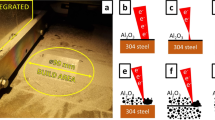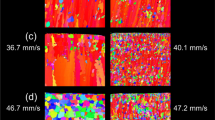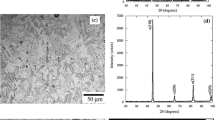Abstract
Emerging lower cost titanium metal powder produced via an electrolytic method has been fully consolidated using spark plasma sintering (SPS) generating microstructures comparable to those observed in Ti–6Al–4V PM product. This is the first time powder from an alternative titanium extraction method has been processed via SPS and it is benchmarked with commercial alloys (CP–Ti, Ti–6Al–4V, and Ti–5Al–5V–5Mo–3Cr). The effect of powder feedstock size, morphology, and alloy chemistry on the consolidated density and microstructure is presented. Through a design of experiments (DoE) type approach the effect of SPS processing conditions on these alloy powders, including maximum sintering temperature, pressure, heating rate, and dwell time were investigated. The SPS process is found to be largely insensitive to feedstock size and morphology, although very large or highly porous powder particles are more difficult to fully consolidate. The maximum sintering temperature and pressure have the largest contribution to achieving full consolidation, with higher pressures and temperatures increasing the final density. Increasing heating rate increases the final grain size, despite less time being spent at the higher temperature and it is thought this is due to bypassing the traditional first phase of sintering. This paper shows that SPS is a viable step for a low-cost manufacturing route, for example to produce preform billets to be finished with a one-step forging operation, especially when combined with the possibility of lower cost powder. In the long-term, SPS will allow a significant reduction in the processing cost, contributing to an increased usage of titanium powder feedstock for a range of applications. This is reinforced by the successful large scale production of a 5 kg SPS Ti-6-4 billet, demonstrating the potential industrial scalability of the process, particularly for the aerospace industry.











Similar content being viewed by others
References
Kraft EH (2004) Summary of emerging titanium cost reduction technologies. Report by ehk technologies, Vancouver, WA. Study for US DofE and ORNL/Subcontract 4000023694
Hurless BE, Froes FH (2002) Lowering the cost of titanium. AMPTIAC Q 6:3–9
Fray DJ (2008) Novel methods for the production of titanium. Int Mater Rev 53:317–325. doi:10.1179/174328008X324594
Chen G, Fray D, Farthing T (2000) Direct electrochemical reduction of titanium dioxide to titanium in molten calcium chloride. Nature 407:361–364. doi:10.1038/35030069
Mellor I, Grainger L, Rao K, Deane J, Conti M, Doughty G, Vaughan D (2015) Titanium powder production via the metalysis process. In: Qian M, Froes FH (eds) Titanium powder metallurgy: science, technology and applications, 1st edn. Elsevier, Amsterdam, pp 51–68
Jackson M, Dring K (2006) A review of advances in processing and metallurgy of titanium alloys. Mater Sci Technol 22:881–887. doi:10.1179/174328406X111147
Druz VA, Moxson VS, Chernenkoff R, Jandeska WF, Lynn J (2006) Blending an elemental approach to volume titanium manufacture. Met Powder Rep 10:16–21
Norgate TE, Wellwood G (2006) The potential applications for titanium metal powder and their life cycle impacts. JOM 58:58–63. doi:10.1007/s11837-006-0084-y
Froes FH, Mashl SJ, Moxson VS, Hebeisen JC, Druz VA (2004) The technologies of titanium powder metallurgy. JOM 56:46–48
Lutjering G, Williams J (2003) Titanium: engineering materials and processes, 2nd edn. Springer, Hiedelberg, pp 50–52
Eriksson M, Radwan M, Shen Z (2013) Spark plasma sintering of WC, cemented carbide and functional graded materials. Int J Refract Metals Hard Mater 36:31–37. doi:10.1016/j.ijrmhm.2012.03.007
Orrù R, Licheri R, Locci AM, Cincotti A, Cao G (2009) Consolidation/synthesis of materials by electric current activated/assisted sintering. Mater Sci Eng 63:127–287. doi:10.1016/j.mser.2008.09.003
Musa C, Licheri R, Locci AM, Orrù R, Cao G, Rodriguez MA, Jaworska L (2009) Energy efficiency during conventional and novel sintering processes: the case of Ti–Al2O3–TiC composites. J Clean Prod 17:877–882. doi:10.1016/j.jclepro.2009.01.012
Chennoufi N, Majkic G, Chen YC, Salama K (2009) Temperature, current, and heat loss distributions in reduced electrothermal loss spark plasma sintering. Metall Mater Trans A 40A:2401–2409. doi:10.1007/s11661-009-9934-x
Handtrack D, Despang F, Sauer C, Kieback B, Reinfried N, Grin Y (2006) Fabrication of ultra-fine grained and dispersion-strengthened titanium materials by spark plasma sintering. Mater Sci Eng 437:423–429. doi:10.1016/j.msea.2006.07.143
Sumida M, Kondoh K (2005) In-Situ synthesis of Ti matrix composite reinforced with dispersed Ti 5 Si 3 particles via spark plasma sintering. Mater Trans 46:2135–2141
Nicula R, Lüthen F, Stir M, Nebe B, Burkel E (2007) Spark plasma sintering synthesis of porous nanocrystalline titanium alloys for biomedical applications. Biomol Eng 24:564–567. doi:10.1016/j.bioeng.2007.08.008
Sakamoto Y, Moriyama S, Endo M, Kawakami Y (2008) Mechanical Property of Porous Titanium Produced by Spark Plasma Sintering. Key Eng Mater 385–387:637–640. doi:10.4028/www.scientific.net/KEM.385-387.637
He D, Fu Z, Wang W, Zhang J, Munir Z, Liu P (2012) Temperature-gradient joining of Ti–6Al–4V alloys by pulsed electric current sintering. Mater Sci Eng 535:182–188. doi:10.1016/j.msea.2011.12.061
Miriyev A, Stern A, Tuval E, Kalabukhov S, Hooper Z, Frage N (2013) Titanium to steel joining by spark plasma sintering (SPS) technology. J Mater Process Technol 213:161–166
Chaudhari R, Bauri R (2014) Microstructure and mechanical properties of titanium processed by spark plasma sintering (SPS). Metallogr Microstruct Anal 3:30–35. doi:10.1007/s13632-013-0112-6
Menapace C, Vicente N, Molinari A (2013) Hot forging of Ti–6Al–4V alloy preforms produced by spark plasma sintering of powders. Powder Metall 56:102–110. doi:10.1179/1743290112Y.0000000003
Eriksson M, Shen Z, Nygren M (2005) Fast densification and deformation of titanium powder. Powder Metall 48:231–236. doi:10.1179/174329005X71939
Zadra M, Casari F, Girardini L, Molinari A (2008) Microstructure and mechanical properties of cp-titanium produced by spark plasma sintering. Powder Metall 51:59–65. doi:10.1179/174329008X277000
Muñoz S, Anselmi-Tamburini U (2010) Temperature and stress fields evolution during spark plasma sintering processes. J Mater Sci 45:6528–6539. doi:10.1007/s10853-010-4742-7
Anselmi-Tamburini U, Garay JE, Munir ZA (2005) Fundamental investigations on the spark plasma sintering/synthesis process III. Current effect on reactivity. Mater Sci Eng 407:24–30. doi:10.1016/j.msea.2005.06.066
Munir ZA, Quach DV, Ohyanagi M (2011) Electric Current Activation of Sintering: a Review of the Pulsed Electric Current Sintering Process. J Am Ceram Soc 94:1–19. doi:10.1111/j.1551-2916.2010.04210.x
Munir ZA, Anselmi-Tamburini U, Ohyanagi M (2006) The effect of electric field and pressure on the synthesis and consolidation of materials: a review of the spark plasma sintering method. J Mater Sci 41:763–777. doi:10.1007/s10853-006-6555-2
Rasband WS, ImageJ, U.S. National Institutes of Health, Bethesda, Maryland, USA, http://imagej.nih.gov/ij/, 1997–2014
Acknowledgements
The authors acknowledge the Engineering and Physical Sciences Research Council’s Advanced Metallic Systems Centre for Doctoral Training for funding Nick Weston. The authors thank the Defence Science and Technology Laboratory for additional funding and Dr. Matthew Lunt for useful discussions. The authors would like to acknowledge Dr. Akemi Nogiwa-Valdez for technical assistance with the SPS furnace. Finally, the authors acknowledge Metalysis Ltd. for supply of material and Dr. Kartik Rao and Lucy Grainger for useful discussions.
Author information
Authors and Affiliations
Corresponding author
Rights and permissions
About this article
Cite this article
Weston, N.S., Derguti, F., Tudball, A. et al. Spark plasma sintering of commercial and development titanium alloy powders. J Mater Sci 50, 4860–4878 (2015). https://doi.org/10.1007/s10853-015-9029-6
Received:
Accepted:
Published:
Issue Date:
DOI: https://doi.org/10.1007/s10853-015-9029-6




